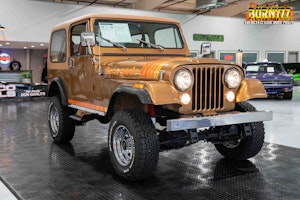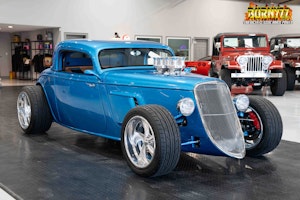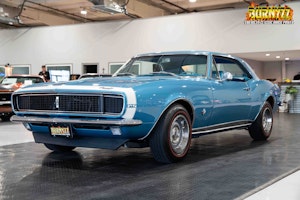Media | Articles
5 Tools That Often Get Misused
Tools are the items and objects we use to complete the tasks we desire to do. At one point in human history we likely only had three tools: a pointy rock, a sharp-edged rock, and a blunt heavy rock. With those three things an industry was born, and it’s one that is today closely linked to the automotive world. We need a lot more tools than those primitive three to get any project done these days, but sometimes we might have the right tool and still decide to use the wrong one. Here are five examples.
If Not Pry Bar, Why Pry Bar Shaped?

Screwdrivers can be precision instruments. They can also be the closest thing to your hand when you need to lever two pieces apart, and oh boy, is it tempting to take that flat-blade screwdriver and shove it in there, maybe even tapping the end of the handle with a hammer to help things along.
Sometimes that works fine, but why take the risk with your tools? Screwdrivers were designed for turning forces and thus it is surprisingly easy to bend the shank or fracture the tip once you start using them in a freestyle manner. If you’re unable to find a pry bar or lever of the appropriate size for your projects, designating one tool for that task is the next best option, though still only half a step short of tool abuse. I have an old damaged flat blade screwdriver that is only used wrong these days. But most screwdrivers do not have shanks that extend completely through the handle, so be advised that any attempts to use a screwdriver like a chisel are likely to break the handle.
Designed to Twirl, Forced to Fight


Sockets are great at removing hardware, but the location of said hardware often means putting those sockets on some type of extension. These simple straight bars have both male and female ends for attaching a ratchet or breaker bar on one end and the socket on the other. That shape also makes them a perfect general-use punch. The broad tip doesn’t focus force much and makes an extension just too perfectly suited for driving out large bolts like those found on suspension hardware. It’s a tool that was designed and born to spin like a ballerina, but often has to pull duty on the offensive line as well.
“The Claw”

At some point a hammer is a hammer, but using a claw hammer under the hood just feels so wrong. Ball-peen hammers are much better for working in the tighter confines of an engine compartment, compared to claw hammers that were designed for framing houses. Ball-peen and dead-blow hammers are likely the most popular for automotive use and come in a range of sizes that help persuade stuck parts and hardware, but that doesn’t stop many people from grabbing what is handy, and I guess we can’t blame them.
Marketplace
Buy and sell classics with confidence
OBD Scan Tools

How could you use an OBD scan tool wrong? Well, I use mine to clear the check engine light and not much more, which quite honestly is massive underutilization of the surprisingly powerful diagnostics abilities that come with a $12 scan tool. I simply don’t want to see the check engine light, because I know the “clogged catalyst” that trips the light isn’t actually being clogged. The problem is that I don’t drive long-enough trips in the winter, and the ECU is putting in additional fuel to try to help the engine warm up and run smoothly, thus the O2 sensors are seeing readings the computer doesn’t like. So I use my scan tool to remove the code and nothing else.
It’s a Lever off the Jack, Too!


Hydraulic floor jacks make lifting our project cars easier than ever. Once the car is up in the air, there is usually (always? without fail?) some large bolt or nut that needs removed, and of course it’s somehow stuck far tighter than the torque spec would suggest. So it’s time to get archaic. Even my two-foot breaker bar is not enough at times, and that’s when the jack donates its handle to create the lever long enough to move most anything. If you’re tempted to use this trick, be careful, the force can be enough to easily strip the teeth inside a ratchet, so it’s best to stick to using a breaker bar. And even then, be sure to have solid socket engagement and a clear path for the long lever to swing in without hitting something else.



















Apparently I have not evolved very far from our ancestors. I have picked up more than one rock from the side of the driveway and used it as I thought mother nature intended. As a hammer, mostly to knock something loose. No sharp edges, easy to hold some heft and a blunt end. Mother natures tool warranty is the best on the planet. There are not enough “guiltys” left in my keyboard to comment on all of the creative indiscretions that have been posted.
For precision work – thumbnail.
I have used the Craftsman screwdriver shown in the title picture to open a can of paint. So sue me.
Using any sharp tool to cut, trim, scrape while pulling it towards you. I learn this lesson about every five years. No stitches yet (not because I didn’t need them).
Ratchet as a hammer.
Although not actually a misuse of a tool, I feel that this is closely related to it. I have not had a roof top antenna on my house for more than 3 decades, yet I still have a 10ft section of an antenna pole that used to reside on the roof of my house proudly lifting that antenna 20 ft above the highest point of my roof. Now it resides in my garage for those occasions when even the jack handle is not enough and just a tad more leverage is needed. I first encountered this on my ’74 VW Beetle trying to break loose the rear axle nuts for a brake job. I even had to have my wife come out and stand on the brake pedal while lifting up on that pole until I heard that satisfying screech of the bolt finally breaking loose!
All good comments, but I have some more to add, based upon my own mistreatment of tools. Never use a piece of electrical conduit as an extension for your breaker bar – they bend too easily. The best thing I have found for a punch is an old fuel pump rod from a SBC (I assume other engines also have them). They are about 5-6″ long and very sturdy. I also use a socket to press out a u-joint from a drive shaft. Interestingly, the shop manual instructions tell you to do it that way.
Last, I hope that photo of the “breaker bar” on the Corvette wheel is only for illustration purposes. Otherwise, it looks like it is positioned to tighten the lug nut, not take it off. That is definitely a “no-no”!
Don’t use a match to check fluid level in car battery cells.
What do I call my screwdrivers that shorted 120 volts? Tent pegs.
How about a 12point 1/2” chrome socket on an impact,
When I was running stage rallies we had a good toolbox full of what we thought were the correct tools.
We also, always, carried the large Plan B tools. Necessity exists.
Ok, I disagree with the screwdriver thing. How many standard slotted screws are used on cars in the last 65 years or so? That whole drawer of various sized & shaped common screwdrivers is plenty to sacrafice a few to pry bar use. And if you break or misshape one, the grinder, torch and vice are ready and willing to craft it in to the next specialized tool you need! 😊
Rope wrench?? ….(knife)
One use for flat blade screwdriver…
When you strip out a Phillips or JIS screw…..
Get your dremel tool with a cut off blade and make a slot for your flat blade screwdriver.
the phrase of never use a screwdriver as a pry bar because the next time you use it as a chisel it will be bent.
Milkaukee has what looks like a straight edge screwdriver. I had to reread the name and description because they call it a “demolition screwdriver “